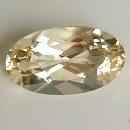|
|
||||||||||||||||
|
||||||||||||||||
|
||||||
|
|
|
|
Orthoclase
(variety
of Feldspar)
|
|
| | |
| First cited in 1801; IMA status: Valid (pre-IMA; Grandfathered) | ||
|
| ||
|
Chemistry |
|
|
| |
|
KAlSi3O8 | |
|
|
Potassium Aluminum Silicate |
|
Molecular Weight: |
278.33 gm |
|
Composition: |
Potassium |
14.05 % |
K |
16.92 % |
K2O |
|
|
Aluminum |
9.69 % |
Al |
18.32 % |
Al2O3 |
|
|
Silicon |
30.27 % |
Si |
64.76 % |
SiO2 |
|
|
Oxygen |
45.99 % |
O |
|
|
|
|
|
100.00 % |
|
100.00 % |
= TOTAL OXIDE |
|
|
|
||||
|
Classification |
|
|
| |
|
Silicates (Germanates) | |
|
8/J.06-40 | |
|
|
9 : SILICATES (Germanates)
|
|
Related to: |
Feldspar Group. Celsian-Orthoclase Series. Polymorph of Microcline and Sanidine. |
|
Members of Group: |
Feldspar Group: Albite, Amazonite, Andesine, Anorthite, Anorthoclase, Banalsite, Buddingtonite, Bytownite, Celsian, Dmisteinbergite, Hyalophane, Labradorite, Microcline, Oligoclase, Orthoclase, Paracelsian, Reedmergnerite, Sanidine, Slawsonite, Stronalsite, Svyatoslavite |
|
Varieties: |
Aglaurite, Barian Orthoclase, Delawarite |
|
Synonyms: |
Argillyite, Common Feldspar, Cottaite, Leelite, Muldan, Murchisonite |
|
|
|
|
Crystal Data |
|
|
|
|
|
Crystals commonly short prismatic along [100] or [001], tabular on [010], to 20 cm. Cleavable, granular, massive. |
|
|
Common as simple, contact, or penetration twins according to the Carlsbad, Baveno, or Manebach laws. |
|
|
|
|
|
Physical Properties |
|
|
|
|
|
Perfect on {001} and {010}; partings on {100}, {110} and {201} |
|
|
Conchoidal to irregular/uneven |
|
|
Brittle |
|
|
6.0 |
|
|
2.55 - 2.63 (g/cm3) |
|
|
None |
|
|
Barely Detectable; GRapi = 200.97 (Gamma Ray American Petroleum Institute Units) |
|
|
|
|
|
Optical Properties |
|
|
|
|
|
Colorless, white, gray, pale yellow, flesh-red, green; colorless in thin section; may exhibit opalescence or schiller iridescence |
|
|
Transparent to translucent |
|
|
Vitreous, pearly on cleavages |
|
|
1.518 - 1.525 Biaxial ( - ) |
|
|
0.004 - 0.005 |
|
|
Distinct, r > v |
|
|
None |
|
|
|
|
|
Occurances |
|
|
|
|
|
Geological Setting: |
The common feldspar of granites, granite pegmatites, and syenites. In cavities in basalts; in high-grade metamorphic rocks and as a result of potassic hydrothermal alteration; also authigenic and detrital. |
|
Common Associations: |
Albite, Muscovite, Biotite, Hornblende, Schorl, Beryl |
|
Common Impurities: |
Na, Fe, Ba, Rb, Ca |
|
Type Locality: |
Unknown |
|
Year Discovered: |
First cited in 1801 |
|
View mineral photos: | |
|
|
|
|
More Information |
|
|
|
|
|
| |
|
|
|
|
Orthoclase is a component of many rocks, especially alkalic and plutonic acid rocks, also granites, pegmatites and syenites. Feldspars are the most common minerals on the Earth's surface. Gem quality Orthoclase crystals are found at several locations around the world but Madagascar produces the largest cuttable Orthoclase known. Crystals from Itrongahy, Madagascar are very fine, transparent yellow and very large, up to 250 carats. Yellow and colorless catseye gems are known from the gem gravels of Burma (Myanmar) and Sri Lanka. Orthoclase
distribution: Widespread. Fine examples from St. Gotthard,
Ticino, and at Val Giuv, Tavetsch, Graubünden,
Switzerland. In the Zillertal, Tirol, Austria. From
Baveno, Piedmont, in the Pfitschtal, Trentino-Alto Adige,
and at San Piero in Campo, Elba, Italy. At Epprechtstein,
Bavaria, Carlsbad, Bohemia, and Manebach, Thuringia,
Germany. From Cornwall, England. In Russia, from the
Mursinka-Alabashka area, near Yekaterinburg (Sverdlovsk),
Ural Mountains. In the USA, from Maine, at Paris and
Buckfield, Oxford County; at Cornog, Chester County,
and Blue Hill and Lieperville, Delaware County, Pennsylvania.
In California, from the Pala and Mesa Grande districts,
San Diego County; in Colorado, on Mt. Antero, Chaffee
County; at Crystal Pass, Goodsprings, Clark County,
Nevada. From Guanajuato, Mexico. At Tanokamiyama, Shiga
Prefecture, Japan. Gem crystals from Ampandrandava,
Fianarantsoa, and Itrongay, near Betroka, Madagascar.
|
|
|
We
have not photographed our Orthoclase
gems yet. Please
check back soon. |
